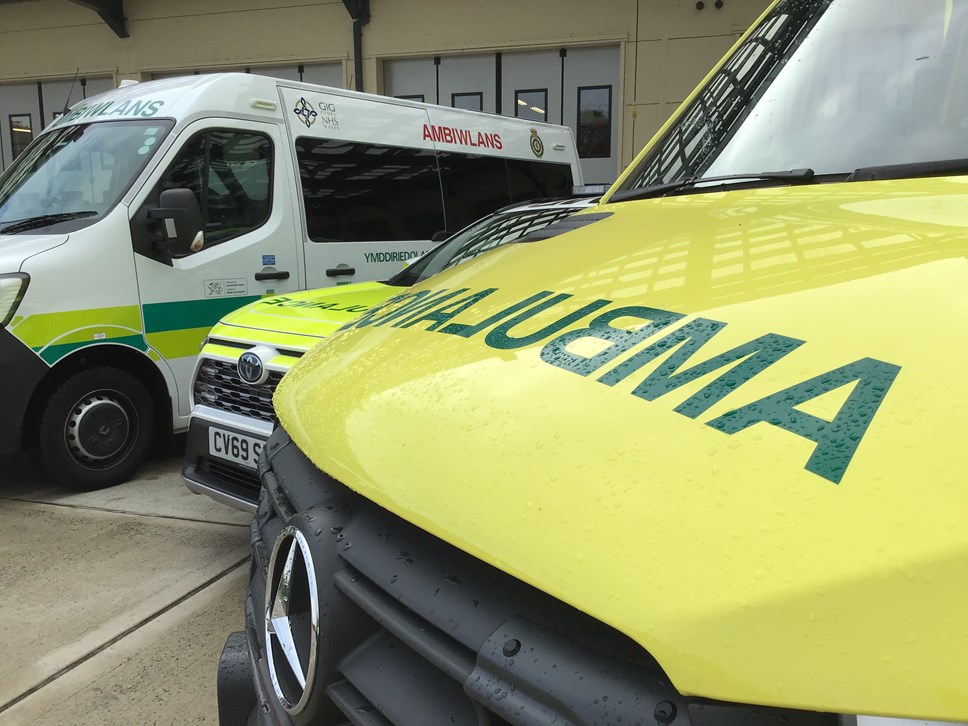
More than £34m invested in ambulance services through the winter months
Buddsoddi dros £34m mewn gwasanaethau ambiwlans dros fisoedd y gaeaf
Health Minister Eluned Morgan has announced more than £34m of extra funding to support the Welsh Ambulance Service through the coming winter months.
It includes £11m to extend military support for ambulances until the end of March – the number of personnel will increase from 100 to 250 early next year.
£15m will fund the replacement of 111 emergency vehicles to improve fleet reliability and availability.
The new fleet will include 39 replacement emergency ambulances, 12 new emergency ambulances and 23 rapid response vehicles.
And more than £8m has been made available to support emergency ambulance services, and non-emergency patient transport services. This is made up of:
- £5m for the Welsh Ambulance Service NHS Trust:
- 36 additional frontline ambulance clinicians to enable a doubling of existing clinical support desk capacity to provide advice over the phone to 999 patients;
- Additional capacity to support winter response, including non-emergency patient transport services
- Support to co-ordinate the response to pressures in the urgent and emergency care system
- A ‘make ready depot’ at Singleton to increase ambulance vehicle availability in Swansea Bay.
2. £2m for non-emergency patient transport services and the recruitment of mental health practitioners to support people with mental health issues over the phone.
3. Further funding to support mental health patients through a transport pilot delivered by St John Cymru Wales.
This funding complements £9.8m previously allocated to Regional Partnership Boards to support people to return to their local communities after admission to hospital. This will help improve hospital patient discharges and ease the pressure on hospital beds.
Health Minister Eluned Morgan said:
“Ambulance services and staff in Wales are under great strain due to the impact of the pandemic and winter pressures.
“We are determined to support the NHS – and all its staff – in every way we can. Investing in the ambulance service shows our commitment to ensuring people can access high-quality emergency care when they need it the most.
“Ambulance clinicians and staff have worked tirelessly throughout the pandemic. I want to thank them for everything they have done to care for people.”
Jason Killens, chief executive of the Welsh Ambulance Service Trust, said:
“Winter is traditionally our busiest period, and when you factor in the pandemic and its record levels of demand and staff absence, we have to redouble our efforts to provide a safe service to the people of Wales.
“The trust and its partners are working hard to find long-term and sustainable solutions to the issues across the entire health and social care system, but in the meantime, we have to look at short-term measures to bolster our capacity as best we can.”
Benjamin Savage, St John Ambulance Cymru’s chief operating officer, said:
“We’re pleased to see more funding being made available to ambulance services across Wales ahead of a challenging winter period.
“We’ve already seen the benefits of Welsh Government funding for the communities we support this year with the launch of our mental health transport service, which has enabled us to look after hundreds of people who have needed our help.”
Notes to editors
Benefits of investing in more emergency services vehicles
- Fewer major breakdowns while responding to patient calls or conveying patients to hospital
- Better vehicle reliability leading to lower vehicle down-times for servicing and repairs
- Fewer defects during operational shifts, increasing vehicle availability and thus supporting front line operations in making ambulance crews available to respond
- A modern clinical interior and therefore better infection control
- Better value for money through the procurement of more fuel-efficient vehicles that will reduce operating costs
- Lower maintenance and repair costs
- Reduced CO2 emissions through the procurement of Euro 6 compliant vehicles reducing adverse impacts on the environment and community
- A better clinical environment for front line staff to operate from, being resourced with the latest clinical equipment to improve patient outcomes
- Clean, well equipped and high quality vehicles capable of meeting the public’s expectations and maintaining a positive public image of the service
The vehicle replacement programme for 2022-23 consists of:
|
2022/2023 Vehicle Replacements |
||
|
Service |
Description |
Qty |
|
Emergency Operations |
Emergency Ambulances (EA) (12 new, 39 replacement) |
51 |
|
Emergency Operations |
Rapid Response Vehicles (RRV) |
23 |
|
Non-Emergency Patient Transfer System (NEPTS) |
Large (Stretcher) |
16 |
|
Non-Emergency Patient Transfer System |
Large (Double Wheelchair) |
6 |
|
Non-Emergency Patient Transfer System |
Small (Single Wheelchair) |
15 |
|
Total: |
|
111 |
